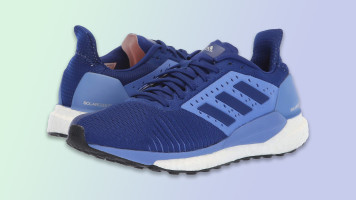When I started running, I was much heavier than I am today — and my feet were flat.
My form was a joke. I hurt myself constantly and developed terrible habits that cost me both in physical pain and in the time I lost to achieve better fitness. I struggled through the early stages of that journey until I realized my shitty, old shoes were just not going to cut it. I needed serious support for my weak ankles, and I needed to start paying attention to my gait while I ran (which is comically difficult to do).
As a result, I started upgrading my running shoes and buying them with much more intention. Going back to 2017, I largely relied on two different shoes.

With overpronating support and cushioning that helps you bounce back, these will keep you cool and going all day.

Thicker all around and slightly heavier than the Vongos, these shoes will help your lifts and dips (and everything in between) on top of supporting your runs.
They both provided me the stability I wanted and got ever closer to the lightness I was searching. The more support your shoe has, the more it’ll likely weigh. That’s not terribly bad. My 270-pound frame in 2016 allowed me to more easily lift shoes that might’ve been some ounces heavier than others. As I lost weight, though, heavier shoes became more noticeable — but so did my decreasing reliance on them.
Pronation Determines Shoe Support and Stabilization
If you’re going to be buying shoes in the near (or far) future, you’re likely going to get one of three different types, and it’s all got to do with your feet and their pronation. That’s the rotating mobility in your feet that partly determines how your foot impact the ground on landing. Here’s an extremely basic breakdown of the three dominant types of pronation most people contend with:
- Basic pronation is the control group, wherein you land on the ball of your foot and a small portion of your heel. It’s a good balance and means you need less supportive shoes because you’re more on track (no pun intended)
- Overpronation results in impact on the inside edge of your feet (and shoes), an effect of rolling your feet inward during movement.
- Supination results in impact on the outside edge of your feet, an effect of rolling your feet outward.
As with most divisions on Earth, we all fall on a grid somewhere along the gamut. A good way to determine your place is to take a look at the soles of some well-worn shoes. At eye-level, do the bottom of their soles slant one way or the other?
Shoes For (Basic) Pronated Feet
You need the least support, but that doesn’t mean your run or other activities won’t benefit from as much of it as you like. Definitely opt for cushion but also feel free to prioritize lightness and a semi-curved structure.

Saucony promises "some pep in your step" with the responsiveness of the lightweight Kinvara 10s.

With neutral support and a lightweight cushioning structure, you're looking at a good response with flexible feedback.
Shoes For Overpronated And Supinated Feet
You need more support, but that doesn’t mean you necessarily have to sacrifice all the other features you’re looking for. Important to note here is that a good shoe is an investment and so are your feet, ankles, knees, and back — each of which is vulnerable to the instability of a less-supportive shoe.

ASICS promises a "smooth ride" in the Kayanos and a perfect blend of support, balance, and performance.

Brooks is iconic for top-level support performance footwear and the Adrenalines pack a perfect punch that's designed to lower harmful impact on your knees.
Scouted is internet shopping with a pulse. Follow us on Twitter and sign up for our newsletter for even more recommendations and exclusive content. Don’t forget to check out our coupon site to find activewear deals from Nike, adidas, and more. Please note that if you buy something featured in one of our posts, The Daily Beast may collect a share of sales.






